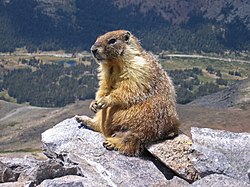Marmot: Difference between revisions
m Reverted edits by Bellamamma to last revision by XLinkBot (HG) |
Bellamamma (talk | contribs) →Examples of species: adding our photos of yellow bellied marmot, Spokane, Washington) |
||
| Line 77: | Line 77: | ||
</gallery> |
</gallery> |
||
<div style="clear: both"></div> |
<div style="clear: both"></div> |
||
[[File:spo_marmot.jpg]] Yellow Bellied Marmot in Spokane, Washington [http://www.youtube.com/watch?v=f79nXSMbeG0] |
|||
==References== |
==References== |
||
Revision as of 18:52, 28 July 2009
| Marmot Temporal range: Late Miocene - Recent
| |
|---|---|

| |
| Yellow-bellied Marmot in Yosemite National Park | |
| Scientific classification | |
| Kingdom: | |
| Phylum: | |
| Class: | |
| Order: | |
| Family: | |
| Subfamily: | |
| Tribe: | |
| Genus: | Marmota Blumenbach, 1779
|
| Species | |
|
Marmota baibacina | |
Marmots are members of the genus Marmota, in the rodent family Sciuridae (squirrels).
Marmots are generally large ground squirrels. Those most often referred to as marmots tend to live in mountainous areas such as the Alps, northern Apennines, Carpathians, Tatra, and Pyrenees in Europe, the Rockies, the Black Hills and the Sierra Nevada in the United States, Northern Canada and Ladakh in India. However, the groundhog is also properly called a marmot, while the similarly-sized but more social prairie dog is not classified in the genus Marmota but in the related genus Cynomys.
Marmots typically live in burrows, and hibernate there through the winter. Most marmots are highly social, and use loud whistles to communicate with one another, especially when alarmed.
The name marmot comes from French marmotte, from Old French marmotan, marmontaine, from Old Franco-Provençal, from Low Latin mures montani "mountain mouse", from Latin mures monti, from Classical Latin mures alpini "Alps mouse".
Marmots mainly eat greens. They eat many types of grasses, berries, lichens, mosses, roots and flowers.
Species
The following is a list of all Marmota species recognized by Thorington and Hoffman (2005). They divide marmots into two subgenera.
- Genus Marmota - marmots
- Subgenus Marmota
- Alpine Marmot Marmota marmota found only in Europe in the Alps, northern Apennines in Italy, Carpathians, Tatra, and reintroduced in the Pyrenees.
- Gray Marmot or Altai Marmot Marmota baibacina Siberia
- Bobak Marmot Marmota bobak Central Europe to Central Asia
- Alaska Marmot, Brower's Marmot or Brooks Range Marmot Marmota broweri Alaska
- Black-capped Marmot Marmota camtschatica Eastern Siberia
- Long-tailed Marmot, Golden Marmot or Red Marmot Marmota caudata Central Asia
- Himalayan Marmot or Tibetan Snow Pig Marmota himalayana Himalaya
- Menzbier's Marmot Marmota menzbieri Central Asia
- Woodchuck, Groundhog, or Whistlepig Marmota monax North America
- Tarbagan Marmot, Mongolian Marmot or Tarvaga Marmota sibirica, Siberia
- Subgenus Petromarmota
- Hoary Marmot Marmota caligata Northwestern North America
- Yellow-bellied Marmot Marmota flaviventris South western Canada, Western United States
- Olympic Marmot Marmota olympus Olympic Peninsula, Washington, USA
- Vancouver Island Marmot Marmota vancouverensis Vancouver Island, British Columbia, Canada
- Subgenus Marmota
Examples of species
-
Groundhog, Marmota monax
-
Alpine Marmot in the Massif des Écrins, southern France.
-
Drawing of Bobak Marmot
-
Video of adult marmot whistling in Gothic, Colorado, USA
File:Spo marmot.jpg Yellow Bellied Marmot in Spokane, Washington [1]
References
- Conesa, J., Heffner, R. S. and Heffner, H. E. (1991). Hearing in large rodents: Groundhogs Marmota monax. Poster/abstract presented at the 14th midwinter meeting of the Association for Research in Otolaryngology (ARO).
- Conesa, J., Koay, G. and Heffner, R. S. (1992). Sound localization in a large rodent, Marmota monax. Abstract in the 15th midwinter meeting of the Association for Research in Otolaryngology (ARO).
- Thorington, R. W. Jr. and R. S. Hoffman. 2005. Family Sciuridae. Pp. 754-818 in Mammal Species of the World a Taxonomic and Geographic Reference. D. E. Wilson and D. M. Reeder eds. Johns Hopkins University Press, Baltimore.








